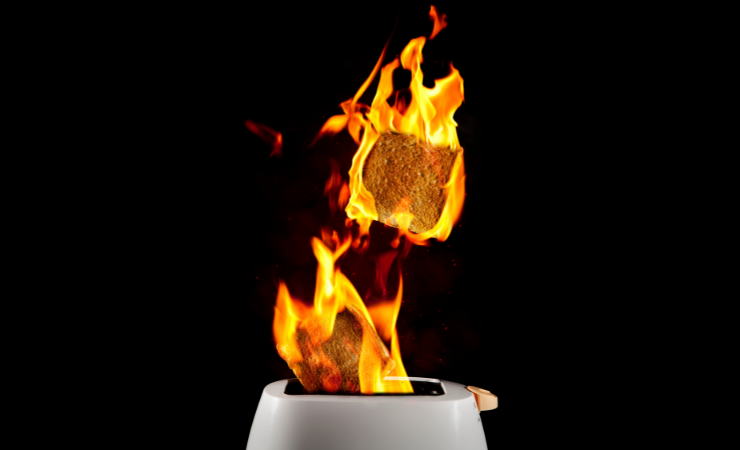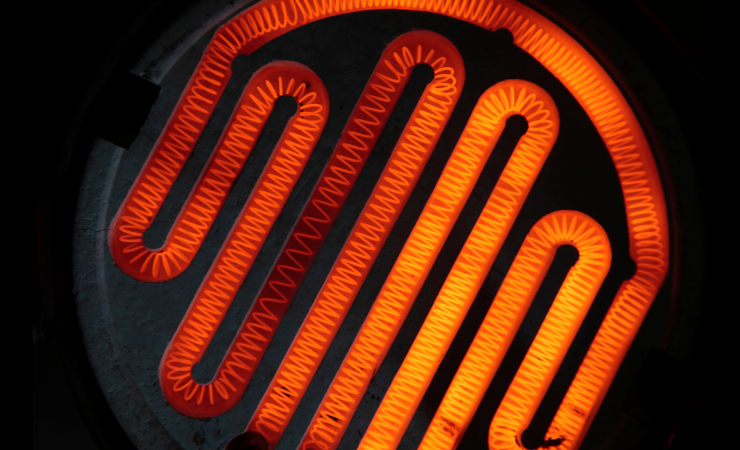I am a “tinkerer” by nature, which means I love to take things apart to see how they work. Sometimes I fix broken things. Other times, I just take them apart to learn more about their design.
This guide will help you understand:
- The parts of a toaster that get hot.
- The danger of touching the heating elements in a toaster.
- What to do if the toaster gets too hot.
How Hot is a Toaster?
Bread turns to toast when the starches in the bread are heated up enough to caramelize. The temperature needed for the hot ambient air in a toaster, which makes the bread turn brown, is around 310°F (146°C).
The heating element inside a toaster is a nickel-chromium alloy. The electrical current that runs through it heats it to make it red hot, with a temperature of 1,100°F to 1,200°F (519°C to 566°C).
The nickel and chromium alloy (“nichrome) used to make the heating element of a toaster was patented in 1906. The alloy is oxidation-resistant, so it will not rust easily.

Wire made from this alloy has a high resistance to electricity. This resistance means that little of the current passes through the wire when you connect an electrical circuit to a nichrome wire. Instead, the electrical energy transforms into heat.
The heat makes infrared light. That energy is the red light you can see inside a toaster when it is operating. The infrared spectrum of light is what does the cooking of the bread to make toast.
Nichrome has a very high melting point of around 660°F (1,400°C). The wire can get read hot without melting. Besides using nichrome in toasters, it is commonly using for the heating elements in many other appliances, such as electrical heating systems and water heaters.
Other excellent properties of nichrome wire are that it cools off quickly after the electricity goes off, and the wire does not break easily. It can be heated and then reheated thousands of times without breaking.
If a toaster is all-metal construction, its sides can get hot too while it is operating. Some older toasters can burn your fingers if you touch them while they are toasting the bread.
The newer designs are called “cool-to-the-touch” toasters. These innovative toasters work to isolate the heat inside the toaster by having highly insulated outer housings. To learn more about this style, read my reviews of cool-to-the-touch toasters here.
Spiced editors show many ways to toast bread to perfection, and they say on their blog that,
“Everyone loves the perfect slice of toast.”
How does a toaster get so hot?
A dial on most toasters controls how much electricity runs through the switch that releases the pop-up tray when the toast is ready. A lower setting that sends less current through the switch takes a longer time for the switch to activate. Using a higher setting with more current increases the amount of heating, which triggers the switch more rapidly.
It takes a little longer to heat up the switch in colder temperatures, so your toast will be more well-done in the winter than in summer, when the kitchen is cooler, all other things being equal.
Is it dangerous if a toaster gets too hot?
There is the risk of a fire if the toaster gets too hot. A short circuit inside may cause a spark and set the crumbs in the tray on fire or, worse, catch something else in the kitchen on fire.
Paul Davis of Paul Davis Renovations says,
“For a toaster fire, act swiftly and keep calm because you can save your family and your home.”
This video, produced by LaurenzSide, shows how she nearly burned her house down with a toaster fire caught on the security camera footage.
Do not let a toaster fire destroy your house.
To learn more about how the inner workings of a toaster function, read my guide here, on how to repair a toaster that will not get hot because the lever will not stay down.
How to Prevent a Toaster From Getting Too Hot
Here are ten tips on how to avoid a toaster fire:
- Do not use a toaster next to any flammable materials.
- Do not put it on a countertop next to other things that can easily catch fire.
- Do not plug a toaster into an overloaded electrical circuit.
- Do not put a toaster near the window covered with curtains that could be blown into the toaster by a breeze.
- Do not put any paper on top of a toaster.
- Unplug a toaster when not in use.
- Never let young children use a toaster unattended.
- Clean your toaster regularly.
- Check the electrical cord for any damage.
- Always have a fully-recharged fire extinguisher, with the correct chemicals in it for proper use in a kitchen, mounted on the wall nearby.
Wrapping something in aluminum foil before heating it in a toaster can cause the toaster to overheat. Learn more about the dangers of using aluminum foil here.
Putting anything made of metal in a toaster is risky because if the metal comes into contact with the heating element, this can cause a spark and start a fire.
This video, produced by Bron Afon, shows how to avoid setting your cupboards on fire by pulling your toaster out from underneath when using it.
Then, when it cools down after use, push it back towards the kitchen wall. I also recommend unplugging it when not in use.
Summing Up
The basic functions of a toaster have been nearly the same for the past 100 years. It is a marvelous invention with elegant simplicity and produces a tasty result that almost everyone likes. Perfectly toasted bread, which is still warm from the toaster and smothered with your favorite toppings, is delightful. I am getting very hungry just thinking about it.
- Lava Rocks Vs. Fire Glass – What Is Better for a Fire Pit? - November 15, 2023
- How to Light a Propane/Gas Fire Pit with a Manual or Electronic Ignition System - November 8, 2023
- How Long Does a Propane Tank Last for a Fire Pit - October 9, 2023


